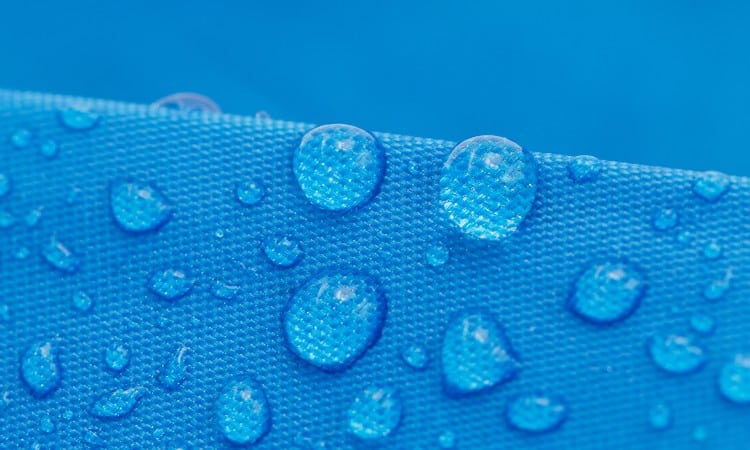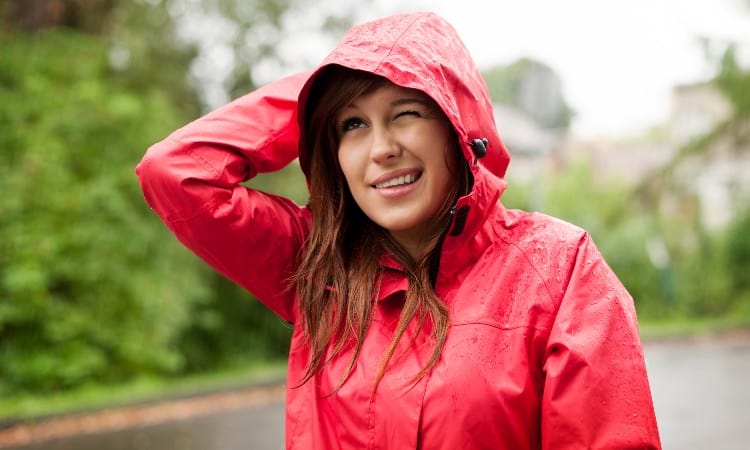Polypropylene fabric is a plastic-based material that comes in many varieties that have very useful characteristics. For this reason, polypropylene fabric has many different uses ranging from medical applications to garment manufacturing to landscaping. However,among all the useful characteristics, is polypropylene fabric waterproof?
Polypropylene fabric is waterproof, generally speaking. The fabric can be manufactured and finished in a variety of ways, resulting in the material being more water-resistant in some instances than in others. So, in one or more of its different available forms, it is waterproof.
That may not seem like much of a straightforward answer, but it is not as complicated as it seems. In this article, we´ll simplify this answer and explain just what it means for a fabric to be waterproof and how this relates to polypropylene fabric. We´ll also take a look at the circumstances under which polypropylene fabric is waterproof and how you can use waterproof polypropylene fabric.

What Does it Mean for a Fabric to be Waterproof Anyway?
When we talk about fabric being waterproof, generally we mean that water cannot pass through the fabric. Under this definition, though, virtually no fabric is truly waterproof. This is because the ability of water to pass through a fabric depends on both the size of water droplets and the pressure being exerted on those water droplets.
So, while at a certain size and pressure a water droplet may not be able to pass through a fabric, with enough pressure a water droplet will pass through any permeable fabric (Meaning a fabric with spaces, however small, in it.).
Waterproof fabrics are commonly associated with a measurement of their resistance to water pressure. Different tests are used to measure how much water pressure a fabric can stand up to before water seeps through it.
These tests will show if a fabric can withstand scenarios such as 5,000 mm, 10mm, or 20mm of water pressure within given test parameters. Then those numbers are used to give an idea of just how waterproof a fabric is. Therefore, the fabric will be considered waterproof simply if it resists water up to a reasonable pressure.
The ability to be waterproof directly relates to how permeable to water a fabric is. A fabric is generally considered to be waterproof if it is manufactured in such a way that only miniscule particles are able to pass through it. This is generally the case when there are only microscopic spaces found in the materials themselves, such as when a fabric is very tightly woven.
Besides tightly woven fabrics, many of the varieties of non-woven polypropylene fabric are also manufactured with such infinitesimally small spaces in their material that only the most tiny particles can pass through them. In fact, being non-woven can permit for even smaller spaces to be found in the material than in woven materials.
When a fabric is manufactured so that it only has small spaces through which particles can pass, this provides a simple physical barrier to water and a level of waterproofing in itself. Fabric can also be made waterproof by being treated with a substance that repels water. This is why many fabrics that are intended to be waterproof are coated with a water repellent, such as DWR.
In the case of woven polypropylene, a laminate is often used for waterproofing. Similarly, for non-woven polypropylene, a backing of an even more waterproof material may be used, or the non-woven polypropylene may be layered, as in the case of SMS polypropylene.
So, Is Polypropylene Fabric Waterproof?

With the above understanding of what it means for a fabric to be waterproof, is polypropylene fabric waterproof? As stated at the beginning of this article, polypropylene fabric is waterproof under certain conditions. The conditions include the way in which the fabric was manufactured and if the fabric was given a waterproof treatment.
Woven vs. Non-Woven Polypropylene Fabric and Their Waterproof Properties
The two most basic ways polypropylene fabric can be manufactured is to be woven or non-woven. Woven polypropylene is made up of plastic threads that are woven into a fabric. Whereas non-woven polypropylene is created in a number of different ways to form a variety of different patterns. Examples of non-woven polypropylene are spunbonded polypropylene, lacespun polypropylene, and melt-blown polypropylene.
Typically, a woven polypropylene fabric will be resistant to water passing through it depending on how tightly woven it is. A looser weave will allow water to pass through more easily than a tighter weave will. Woven polypropylene fabric can also be made fully waterproof with a laminate finish. This level of waterproofing will make the fabric, even though it is woven, no longer breathable.
As far as non-woven polypropylene fabric goes, the method of manufacturing and finishing also determines the level to which it is waterproof. Since non-woven polypropylene is manufactured in a greater variety of patterns than woven polypropylene, it has an even greater range of waterproof possibilities. Similarly, it can also take treatments, such as a polyethylene coating, which makes it highly waterproof.
How Being Breathable Makes Polypropylene Fabric a Particularly Useful Waterproof Fabric
 Waterproof varieties of polypropylene fabric are particularly useful. Untreated non-woven polypropylene can be both waterproof and breathable.
Waterproof varieties of polypropylene fabric are particularly useful. Untreated non-woven polypropylene can be both waterproof and breathable.
This is quite a feature, as many waterproof fabrics are not breathable due to the properties that make them waterproof. Non-woven polypropylene can keep water out, and also wick moisture away since it has spaces in its makeup that are too small to let water in but are large enough to let vapor out.
The combination of being both breathable and waterproof makes waterproof non-woven polypropylene a good choice for use in outerwear, such as this jacket. Designed to be breathable, waterproof, and lightweight, the jacket is a good example of three of the most useful properties non-woven polypropylene can have.
When is Polypropylene Fabric NOT Waterproof?
Few fabrics are completely waterproof, so, even though a polypropylene fabric is marketed as waterproof, it may not be as waterproof as you need. Additionally, some polypropylene fabric is simply not waterproof because of the way it is manufactured. For example, some loosely woven polypropylene fabric will allow water to easily seep through it. Also, while a polypropylene fabric may initially be waterproof, age and use may break down its waterproof properties.
To test if a polypropylene fabric is waterproof, you can splash it with water to see if the water beads. Water beading is a good sign that a fabric resists or repels water. If possible, you can also put the fabric over a container and pour some water on the fabric to see if any of the water drips through into the container.
How to Use Waterproof Polypropylene Fabric
How is Waterproof Polypropylene Fabric Commonly Used?
A waterproof laminated woven polypropylene fabric and spunbonded non-woven polypropylene fabric are both commonly used to make reusable shopping bags. The spunbonded polypropylene fabric is also frequently found in tote bags, garment bags, or in those free conference bags.
Non-woven polypropylene is also used as interfacing in garment making and in upholstery to cover the underside of chairs and couches. As previously mentioned, you will also find waterproof polypropylene in outdoor wear. It has many roles, from gowns to bagage,and even in the medical field as bandaging. As far as home use, one of the most common current applications is as a filter for use in homemade masks.
Where to Find Waterproof Polypropylene Fabric
 Given the many uses of waterproof polypropylene fabric, you may find the material in items you already have around your house. So, if you are looking for waterproof polypropylene fabric for a project, you may just want to clean out your closet to see what you could repurpose. You may just find a throw-away conference bag that you can put to good use.
Given the many uses of waterproof polypropylene fabric, you may find the material in items you already have around your house. So, if you are looking for waterproof polypropylene fabric for a project, you may just want to clean out your closet to see what you could repurpose. You may just find a throw-away conference bag that you can put to good use.
Besides seeing what you may have laying around the house, you can also buy waterproof polypropylene fabric online. Such a product is an example of non-woven polypropylene. From the photo examples you can see how the fabric is both thin enough to be breathable but also able to stand up to water.
Tips and Considerations in Using Waterproof Polypropylene Fabric
Once you have found some waterproof polypropylene fabric, you may want to test if the fabric is waterproof enough for your purposes. This is true whether you have bought or found your fabric. How waterproof the fabric the fabric depends upon its manufacture, and that age and use can also affect the waterproof abilities of the fabric. The waterproof tests outlined above should suffice for this.
You will also want to keep in mind how breathable you need your waterproof polypropylene fabric to be for your intended purpose. So remember, while a laminated woven polypropylene fabric is quite waterproof, it is not breathable. Similarly, an extremely breathable non-woven polypropylene fabric may not be waterproof enough for your needs.
Finally, if you find that you need your waterproof polypropylene fabric to be even more waterproof, you do have some options. You can layer the fabric with itself and/or other fabrics, or you can treat it with a waterproofing treatment. Further, since sewing a waterproof fabric can compromise its waterproof properties, you can tape the seams of your project so that water is less likely to seep through seams and other sewn places.
Conclusion
Polypropylene fabric is a varied and useful product. As a waterproof fabric, it is suitable for a number of different uses and has particular value as a fabric that is both breathable and waterproof. However, how waterproof depends upon the way it is manufactured and what treatments it is given, which is definitely something to keep in mind when selecting it as a waterproof fabric.